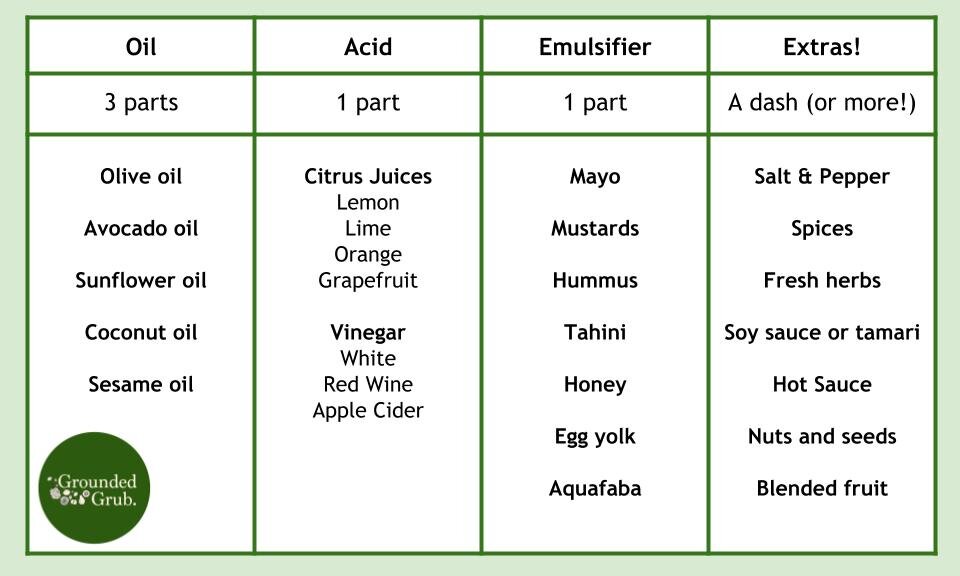Make-Your-Own Salad Dressing Guide
While you may catch me eating spinach straight from the bag while browsing at the farmers’ market, most of us can agree that dressing is really what makes a salad. Cesar salads would just be a pile of romaine lettuce if it wasn’t for the iconic mix of flavors in the dressing. Unfortunately, dressings are often packaged in hard (or impossible) to recycle packaging and can be really expensive. And while store bought dressings don’t go bad very quickly, some people don’t like all the extra ingredients (preservatives, sugars, etc.) and half-used bottles of dressing can pile up in the fridge over time. Luckily, you can easily make any of your favorite salad dressings from condiments and other ingredients that you probably already have in your kitchen. Making your own helps you save money because you’re using staple ingredients that have many other uses and it can make you feel good about reducing wasteful packaging.
Personally, making my own dressing is one of my favorite eco “hacks” because it barely takes any time. Sometimes “quick” sustainable swaps aren’t as quick as they seem and can require buying something new or drastically changing the way you cook. Making your own dressing takes minutes, and while it may change the way you cook we promise it will be for the better! Say goodbye to the monotony from using the same jar of dressing for weeks on end! By making your own you are truly in control of flavors and nutrition in a way that is much harder with store bought dressings.
As we head into spring and summer the greens are abounding on farms and this is an amazing time to start making salad using delicious greens grown in your area. At the end of this article we include some recipes for some classic dressings that you may be tempted to buy at the store. But some (“some” being me and Ben...) argue that one of the most appealing things about making your own dressing is the endless possibilities for creativity.
So for that reason, before we get to specific recipes, we want to cover the basics of how to start making your own dressing recipes and how to make the most of whatever you have on hand. For any dressing we make we like to start by thinking about what the fat or oil will be, what the acid will be, and what the emulsifier will be. Emulsion is the process of combining two liquids which would otherwise not mix (think water and oil), and is necessary for a smooth dressing of any kind. For example, you can make some awesome bright and herby dressings using hummus and/or tahini. The thickness of these two things acts as an awesome emulsifier to bring things like olive oil and vinegar or lemon juice together in a totally stable emulsion. Some dressings are unstable emulsions that separate into layers of each ingredient if you don’t shake them well—like an Italian vinaigrette. These dressings are also great but sometimes don’t carry flavor as well.
Once you have those down, flavor becomes completely boundless. We like to add anything from powdered spices, to fresh herbs, to chopped nuts and seeds to develop a flavor profile that meshes with whatever we’re dressing. We’ve made this table to help you make the most of whatever you have in your fridge—and explore all the possibilities for flavor combinations!
Most dressings can store up to a week in the fridge and can be made by simply whisking with a fork in a bowl or shaking up in a jar. I even save old dressing containers and reuse them with my own ingredients.
Cesar Dressing:
2 small garlic cloves, minced
1 teaspoon anchovy paste (I often opt out of this because I don’t like anchovies and I don’t consider this a “staple”
2 tablespoons lemon juice
1 teaspoon Dijon mustard
1 teaspoon Worcestershire sauce
1 cup mayonnaise (make your own vegan mayo by blending 1 cup vegetable oil, 1/2 cup unsweetened soy milk, 2 tsp apple cider vinegar and 1/2 tsp salt)
1/2 cup freshly grated Parmigiano-Reggiano (replace with your favorite vegan alternative if prefered)
1/4 teaspoon salt
1/4 teaspoon freshly ground black pepper
Whisk together and enjoy!
Berry Vinaigrette:
1 cup raspberries, strawberries, blackberries or combination! preferably frozen
1/4 cup lemon juice
1/4 cup white wine vinegar
1/4 cup olive or avocado oil
3 tablespoons honey (sub agave for vegan option)
1/8 teaspoon sea salt optional
Blend together and top with your favorite nuts and seeds. We love pumpkin and walnuts.
Classic Ranch:
1/3 cup buttermilk
1/3 cup mayonnaise (can sub buttermilk and mayo with plain yogurt of choice!)
2 tablespoons chopped parsley
2 tablespoons chives
1 teaspoon dried dill weed
1/4 teaspoon kosher salt
1/4 teaspoon black pepper
1/4 teaspoon garlic powder
Whisk ingredients together and dip away!
Honey Mustard:
2 tablespoons honey
2 tablespoons Dijon mustard
2 tablespoons white vinegar
1/2 teaspoon kosher salt and pepper to taste.
1/4 cup olive oil
Whisk together all ingredients except the olive oil. Keep whisking and gradually add the olive oil.
Asian Inspired Sesame Dressing:
2 tablespoons cider vinegar
1 tablespoon honey
1 1/2 teaspoons grated peeled ginger (can use powdered ginger too)
2 tablespoons sesame oil
1/3 cup vegetable oil (or other neutral oil like sunflower, avocado or olive)
1/2 teaspoon salt and pepper to taste
1/4 teaspoon garlic powder
Whisk all ingredients together and add to noodle salads or other delicious side dishes. I like to add spice as well. You can adjust this basic recipe to better match specific cuisines with the addition of different spices.
Did you make any of these recipes? Or did we miss something in this article? Shoot us a message and let us know! We always love hearing from you!
Inspiration for this piece:

